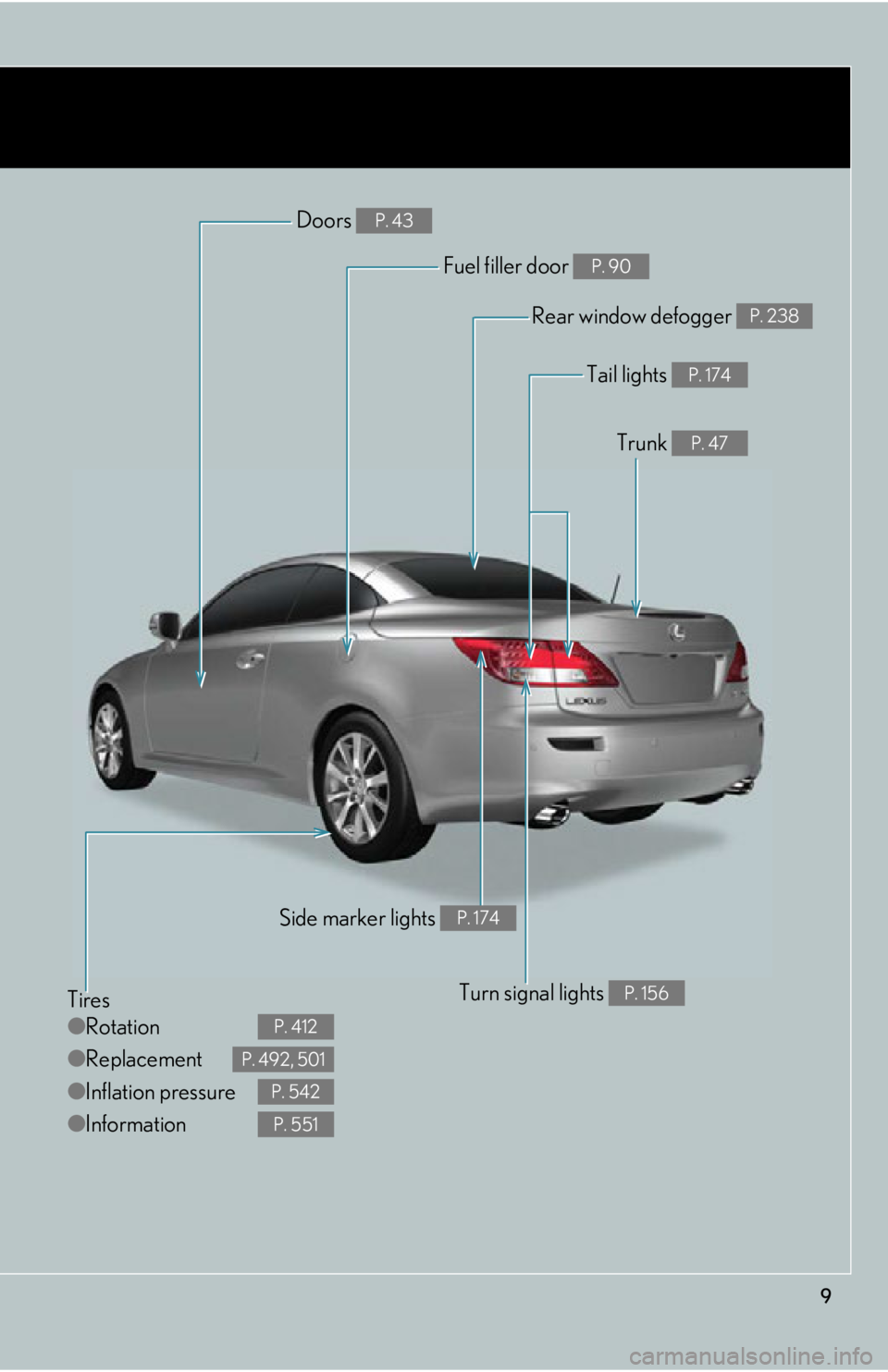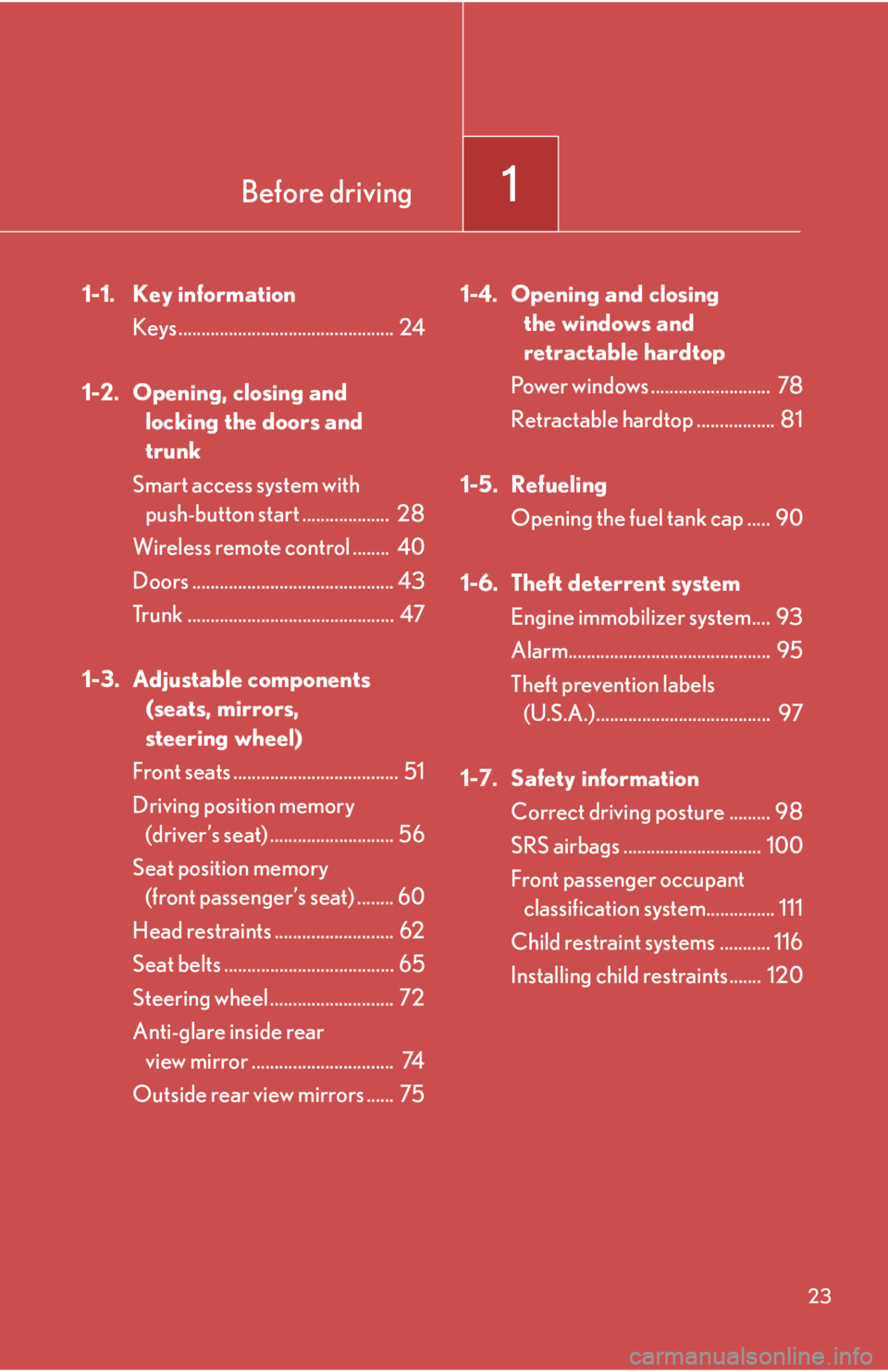window Lexus IS250C 2010 Do-It-Yourself Maintenance / LEXUS 2010 IS350C IS250C OWNERS MANUAL (OM53A24U)
[x] Cancel search | Manufacturer: LEXUS, Model Year: 2010, Model line: IS250C, Model: Lexus IS250C 2010Pages: 594, PDF Size: 7.19 MB
Page 2 of 594

TABLE OF CONTENTSIndex
2
1-1. Key informationKeys ...................................................... 24
1-2. Opening, closing and locking the doors and trunk
Smart access system with push-button start .......................... 28
Wireless remote control .............. 40
Doors.................................................... 43
Trunk..................................................... 47
1-3. Adjustable components (seats, mirrors,
steering wheel)
Front seats ........................................... 51
Driving position memory (driver’s seat) ................................. 56
Seat position memory (front passenger’s seat) ............. 60
Head restraints................................. 62
Seat belts ............................................ 65
Steering wheel.................................. 72
Anti-glare inside rear view mirror ................................................ 74
Outside rear view mirrors ........... 75 1-4. Opening and closing the
windows and retractable
hardtop
Power windows................................ 78
Retractable hardtop........................ 81
1-5. Refueling Opening the fuel tank cap........... 90
1-6. Theft deterrent system Engine immobilizer system ......... 93
Alarm.................................................... 95
Theft prevention labels (U.S.A.) ............................................. 97
1-7. Safety information Correct driving posture ............... 98
SRS airbags ..................................... 100
Front passenger occupant classification system ..................... 111
Child restraint sy stems ................. 116
Installing child restraints ............. 120
1Before driving
Page 4 of 594

TABLE OF CONTENTSIndex
4
3-1. Using the air conditioning system and defogger
Automatic air conditioning system ........................................... 230
Rear window and outside rear view mirror
defoggers .................................... 238
3-2. Using the audio system Audio system type ....................... 239
Using the radio .............................. 242
Using the CD player .................. 250
Playing back MP3 and WMA discs .................................. 257
Operating an iPod
®................... 265
Operating a USB memory....... 273
Optimal use of the audio system ............................................ 282
Using the AUX ad apter ........... 284
Using the steering wheel audio switches ........................... 286 3-3. Using the Bluetooth
®
audio system
Bluetooth
® audio system ........ 289
Using the Bluetooth
®
audio system................................ 292
Operating a Bluetooth
®
enabled portable player ......... 297
Setting up a Bluetooth
®
enabled portable player ........ 300
Bluetooth
® audio system
setup .............................................. 306
3-4. Using the hands-free phone system (for mobile phones)
Hands-free system for mobile phones ............................ 307
Using the hands-free system (for mobile phones) ..................... 311
Making a phone call..................... 319
Setting a mobile phone .............. 323
Security and system setup ....... 328
Using the phone book................ 332
3-5. Using the interior lights Interior lights list........................... 338
• Interior light ................................. 339
• Personal lights ............................ 339
3Interior features
Page 9 of 594

9
Tires
●Rotation
● Replacement
● Inflation pressure
● Information
P. 412
P. 492, 501
P. 542
P. 551
Tail lights P. 174
Trunk P. 47
Rear window defogger P. 238
Doors P. 43
Fuel filler door P. 90
Turn signal lights P. 156
Side marker lights P. 174
Page 12 of 594

12
B
Driving position memory switches
Seat position memory switches
P. 56
P. 60
Door lock switch P. 43
Outside rear view mirror
switches
P. 75
Window lock switch P. 78
Power window switches P. 78
Pictorial indexInterior
Page 15 of 594

15
Without navigation system (type A)
Clock
P. 348
Audio
system
P. 239
Air conditioning
system
P. 230
Rear window and out-
side rear view mirror
defoggers
P. 238
Security indicator
P. 93, 95
Emergency
flasher switch
P. 458
*2: For vehicles with a navigation system, refer to the “Navigation System Owner’s Manual”.
A
Clock
P. 348
Audio
system
P. 239
Air conditioning
system
P. 230
Rear window and out-
side rear view mirror
defoggers
P. 238
Security indicator
P. 93, 95
Emergency
flasher switch
P. 458
Without navigation system (type B)
Page 16 of 594

16
Pictorial indexInstrument panel
A
Navigation
system
*1
Clock P. 348
Audio system*1
Security indicator
P. 93, 95
Emergency flasher
switch
P. 458
Air conditioning
system
*1
With navigation system (type A)
Rear window and
outside rear view
mirror defoggers
*1
Navigation
system
*1
Clock P. 348
Audio system*1
Security indicator
P. 93, 95
Emergency flasher
switch
P. 458
Air conditioning
system
*1
With navigation system (type B)
Rear window and
outside rear view
mirror defoggers
*1
Page 21 of 594

21
CAUTION
■General precautions while driving
Driving under the influence: Never drive your vehicle when under the influence of
alcohol or drugs that have impaired your ability to operate your vehicle. Alcohol
and certain drugs delay reaction time, impair judgment and reduce coordination,
which could lead to an accident that could result in death or serious injury.
Defensive driving: Always drive defensively. Anticipate mistakes that other drivers
or pedestrians might make and be ready to avoid accidents.
Driver distraction: Always give your full at tention to driving. Anything that distracts
the driver, such as adjusting controls, ta lking on a cellular phone or reading can
result in a collision with resulting death or serious injury to you, your occupants or
others.
■General precaution regarding children’s safety
Never leave children unattended in the vehi cle, and never allow children to have or
use the key.
Children may be able to start the vehicle or shift the vehicle into neutral. There is
also a danger that children may injure themselves by playing with the cigarette
lighter, the windows, the retractable hardtop, or other features of the vehicle. In
addition, heat build-up or extremely cold temperatures inside the vehicle can be
fatal to children.
Page 23 of 594

Before driving1
23
1-1. Key informationKeys ............................................... 24
1-2. Opening, closing and locking the doors and
trunk
Smart access system with push-button start ................... 28
Wireless remote control ........ 40
Doors ............................................ 43
Trunk ............................................. 47
1-3. Adjustable components
(seats, mirrors,
steering wheel)
Front seats .................................... 51
Driving position memory (driver’s seat) ........................... 56
Seat position memory (front passenger’s seat) ........ 60
Head restraints .......................... 62
Seat belts ..................................... 65
Steering wheel ........................... 72
Anti-glare inside rear view mirror ............................... 74
Outside rear view mirrors ...... 75 1-4. Opening and closing
the windows and
retractable hardtop
Power windows .......................... 78
Retractable hardtop ................. 81
1-5. Refueling Opening the fuel tank cap ..... 90
1-6. Theft deterrent system Engine immobilizer system.... 93
Alarm............................................ 95
Theft prevention labels (U.S.A.)...................................... 97
1-7. Safety information Correct driving posture ......... 98
SRS airbags .............................. 100
Front passenger occupant classification system............... 111
Child restraint systems ........... 116
Installing child restraints....... 120
Page 32 of 594

32
1-2. Opening, closing and locking the doors and trunk
■Operation signals
A buzzer sounds and the emergency flashers flash to indicate that the doors have
been locked/unlocked. (Locked: Once; Unlocked: Twice)
■Conditions affecting operation
The smart access system with push-button start uses weak radio waves. In the fol-
lowing situations, the communication betw een the electronic key and the vehicle
may be affected, preventing the smart access system with push-button start from
operating properly:
(Ways of coping: P. 5 0 7 )
●When the electronic key battery is depleted
●Near a TV tower, electric power plant, gas station, radio station, large display,
airport or other facility that generates strong radio waves or electrical noise
●When carrying a portable radio, cellular phone, cordless phone or other wire-
less communication devices
●When the electronic key is in contact wi th, or is covered by the following metal-
lic objects
• Cards to which aluminum foil is attached
• Cigarette boxes that have aluminum foil inside
• Metallic wallets or bags
•Coins
• Hand warmers made of metal
• Media such as CDs and DVDs
●When multiple electronic keys are in the vicinity
●When another wireless key (that emits radio waves) is being used nearby
●When carrying or using the electronic key together with the following devices
that emit radio waves
• Another vehicle's electronic key or a wireless key that emits radio waves
• Personal computer or personal digital assistant (PDA)
• Digital audio player
• Portable game system
●If window tint with a metallic content or metallic objects are attached to the rear
window
●Immediately after the retractable hardtop is opened or closed
Page 35 of 594

35
1-2. Opening, closing and locking the doors and trunk
1
Before driving
■To operate the system properly
●Make sure to carry the electronic key when operating the system. Actions such
as locking and unlocking the doors cannot be performed from outside the vehi-
cle if the electronic key is inside the vehicle, even when the retractable hardtop
is open.
●Do not get the electronic key too close to the vehicle when operating the sys-
tem from the outside of the vehicle.
●Depending on the position and holding co ndition of the electronic key, the key
may not be detected correctly and the system may not operate properly. (The
alarm may go off accidentally, or the door lock prevention may not function.)
■Note for the entry function
●Even when the electronic key is within the effective range (detection areas), the
system may not operate properly in the following cases.
• The electronic key is too close to the window or outside door handle, near the
ground, or in a high place when the doors are locked or unlocked.
• The electronic key is near the ground or in a high place, or too close to the rear bumper center when the trunk is unlocked.
• The electronic key is on the instrument panel, rear package tray or floor, or in the glove box when the engine is started or “ENGINE START STOP” switch
modes are changed.
●As long as the electronic key is within the effective range, the doors may be
locked or unlocked by anyone.
●Even if the electronic key is not inside th e vehicle, it may be possible to start the
engine if the electronic key is near the window.
●The doors may unlock if a large amount of water splashes on the door handle,
such as in the rain or in a car wash. (The doors will automatically be locked after
approximately 60 seconds if the doors are not opened and closed.)
●Gripping the door handle when wearing a glove may not unlock the door.
●If the wireless remote control is used to lock the doors when the electronic key
is near the vehicle, there is a possibility that the door may not be unlocked by the
entry function. (Use the wireless re mote control to unlock the doors.)
●A sudden approach to the effective range or door handle operation may prevent
the doors from being unlocked. In this case, return the door handle to the original
position and check that the doors unlock before pulling the door handle again.